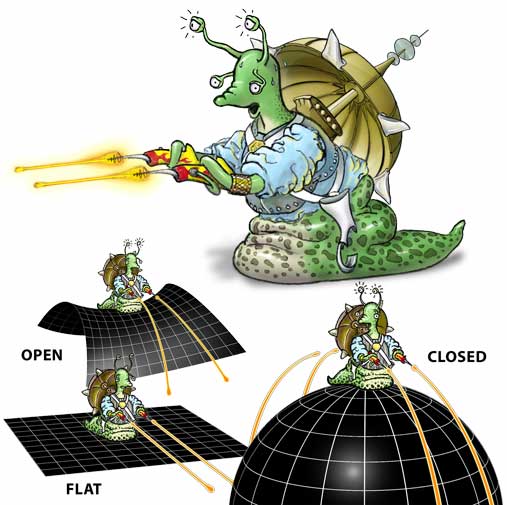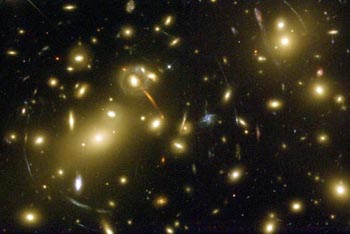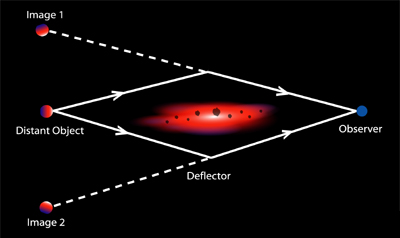In the fifth or sixth grade, I had to do a report. And much like my fifth grade science fair project, which I do remember: I passed in a paper on resistors with a small experiment that my dad all but typed up for me, I had no idea what I was writing. The topic was Einstein’s special relativity. The whole thing was lifted from the appropriate volume of Encyclopedia Britannica kept in my dad’s home office. But what was so special about special relativity? The encyclopedia article explained that the theory was the result of a simplifying assumption or something in Einstein’s general theory, and that this whole thing was really about gravity. I have to admit, I still find the entire enterprise of relativity and gravity mystifying. One of the more outrageous predictions of classical GR are those objects popularized by scary movies like Event Horizon and other popular science fiction called black holes.
Black holes are tricky to define mathematically. Physically, they’re a place where mass becomes “infinitely” dense. [The quotes are there because infinite anything is a physical no-no. If you were to squeeze the mass of the earth into a ball a few millimeters across, then the force of gravity would take over and compress it even further. The math predicts a formation of singularity — the thing at the center of a black hole.] The space around such points acts funny. Because of the strong gravity associated with these objects, if something, a rocket, a lampshade, or a photon of light, for example, gets too close, then it gets drawn in ever closer until it meets collides with the singularity. Then all bets are off, and nobody can say with any amount of certainty what happens. The boundary in space beyond which nothing can return is called the event horizon of the black hole. Because not even light can escape, the structure will look, well, black; hence the name.
Black holes have always made people feel a little uneasy. First off, they’re scary. When I was small, I hated the drain in the bath tub. It was only a matter of time, I thought, before it took me down with the bath water. Black holes evocate the same sort of fear. And according to the big bang, there are tons of tiny, primeval black holes floating around the universe. The thought of it petrifies me. Secondly, black holes cause a few problems. Most notable is the information paradox, something that Stephen Hawking both proposed and recently resolved. The old saying goes that black holes have no hair. To avert the paradox, it turns out that black holes must be fuzzy, that things can escape. The problem stems from a butting of general relativity against quantum mechanics. They both work in their regimes, so what gives?
George Chapline has an answer: there is no such thing as a black hole. Instead, he proposes something whose geometry looks outwardly very similar to a black hole. He calls this something a dark energy star. I met him last spring when he came to give one of the Friday colloquium talks. He motivated his quantum critical points — a concept which neither I nor the New Scientist article I link explains — with the following scenario. [Okay, I will a little: usually we think of temperature as the master of phase transitions. Cool down a gas, like water vapor, and you get a liquid, like water. Cool down further, freeze it, even, and you get a solid, say, ice. Now keep going, cool it down all the way to just above absolute zero. When things that cold, quantum mechanical effects are the dominating factor in phase transitions, not temperature. In this condition weird things can happen, like superconductivity.]
Consider a long cylinder filled with a superfluid. The pressure gradient will be small nearer to the top, at the bottom, it will be large. At the top of the tube attach a speaker which sends out a sound wave. As the wave travels through the liquid it will slow down as the gradient increases. At some height, the wave should stop. What happens, he asks, as the wave meets this surface? If you’re a classical general relativist, you might look at the math and think, “Ah, ha! That’s just like the event horizon of a black hole. So, nothing, the wave will just pass through.” Classical GR lets anything just fall into a black hole. Once you’re inside you can’t send emails or make outgoing phone calls, but outside of that, nothing happens. You wouldn’t feel a thing. The earth could’ve just passed through the event horizon of a super, ultra massive black hole right now and you wouldn’t even know it. But Chapline does some quantum mechanics and says that’s not what happens. Instead, we might expect the magical height at which the wave stops really to represent a quantum critical surface. And the phase transition effects are wild.
In his talk he explained that a sort of Georgi-Glashow process could occur, causing quarks to split into an electron and a positron. This could account for all the anti-matter we see at the centers of galaxies. Using the liquid superconductor analogy, he conjectured that the vortices like those that form when liquid helium might also explain relativistic jets we observe spitting out anti-matter, too. The exciting [or threatening] implication of Chapline’s idea is that there is no singularity, no black hole, just lots of dead stars.
On the other hand, Penrose and Hawking have their names attached to the famed Singularity Theorems. They say that given certain assumptions on the causal structure of a universe, assumptions that we think our universe satisfy, then there needs be a singularity some where in that space-time. What of that? I’m not sure, and I’m not sure I care. Luckily, mathematical general relativity is replete with really interesting questions that are completely divorced of whatever’s going on in this universe. As I like to say, “Physics is the study of this universe, mathematics is the study of all possible universes.”



